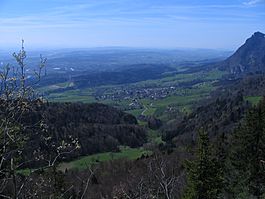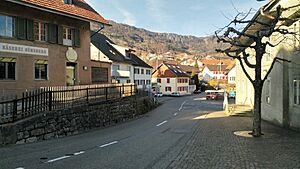Günsberg facts for kids
Quick facts for kids
Günsberg
|
||
|---|---|---|
 |
||
|
||
| Country | Switzerland | |
| Canton | Solothurn | |
| District | Lebern | |
| Area | ||
| • Total | 5.26 km2 (2.03 sq mi) | |
| Elevation | 624 m (2,047 ft) | |
| Population
(Dec 2020 )
|
||
| • Total | 1,179 | |
| • Density | 224.14/km2 (580.5/sq mi) | |
| Postal code |
4524
|
|
| Surrounded by | Attiswil (BE), Balm bei Günsberg, Farnern (BE), Herbetswil, Hubersdorf, Kammersrohr, Niederwil | |
Günsberg is a small town, also called a municipality, located in the Lebern district. It is part of the canton of Solothurn in Switzerland.
History
Günsberg was first mentioned in official records in the year 1307. Back then, it was known as Gunsperch.
Geography
Günsberg covers an area of about 5.25 square kilometers (about 2 square miles). A large part of this land, almost half (46.9%), is used for farming. Forests cover another big portion, about 42.5% of the area. The remaining land is where buildings and roads are found (10.3%), or it's unproductive land (1.0%).
Most of the built-up area is for homes and other buildings (7.2%). Roads and other transport areas make up 2.5%. In the forests, 38.3% of the land is dense forest. Another 4.2% has orchards or small groups of trees. For farming, 12.0% is used for crops. Pastures for animals cover 23.0%, and 11.2% is used for mountain pastures.
The town is located in the Lebern district. It sits at the southern base of the Jura Mountains.
Coat of Arms
The official design of Günsberg's coat of arms shows a red deer jumping. It is placed over three green hills. The background color is gold.
Population and People
Günsberg has a population of about 1,179 people. A small part of the population, about 7.2%, are people from other countries. Over the past ten years (1999–2009), the number of people living here has slightly decreased.
Most people in Günsberg speak German. About 94.4% of the population speaks German. A smaller number of people speak French (1.2%).
In 2000, about 36.9% of the people living in Günsberg were born there. Another 28.0% were born in the same canton (Solothurn). About 21.7% were born elsewhere in Switzerland. Only 8.2% were born outside of Switzerland.
The age groups in Günsberg in 2000 were:
- Children (0-6 years old): 7.4%
- Teenagers (7-19 years old): 15.8%
- Young adults (20-24 years old): 4.8%
- Adults (25-44 years old): 31.8%
- Older adults (45-64 years old): 23.9%
- Seniors (65-79 years old): 12.4%
- Very old seniors (over 80 years old): 3.9%
In 2000, there were 470 homes in Günsberg. On average, about 2.4 people lived in each home. About 22.3% of homes had only one person living there.
The chart below shows how Günsberg's population has changed over many years:

Economy
In 2010, Günsberg had a low unemployment rate of 1.7%. This means most people who wanted to work had jobs.
The town's economy is divided into three main parts:
- Primary sector: This includes jobs like farming and forestry. In 2008, 38 people worked in this sector, with 14 businesses.
- Secondary sector: This includes jobs in manufacturing (making things) and construction (building things). In 2008, 41 people worked in this sector, with 13 businesses.
- Tertiary sector: This includes jobs that provide services, like shops, restaurants, education, and healthcare. In 2008, 77 people worked in this sector, with 24 businesses.
Most people who live in Günsberg travel to other towns for work. In 2000, 464 people left Günsberg to work elsewhere. Only 100 people came into Günsberg for work. About 12.6% of workers used public transport to get to work. Most (67.2%) used a private car.
Religion
Based on information from 2000, people in Günsberg follow different religions:
- About 46.4% were Roman Catholic.
- About 28.1% belonged to the Swiss Reformed Church.
- A small number of people belonged to other Christian churches (including Orthodox and Christian Catholic).
- About 0.34% of the population was Islamic.
- About 15.84% of the people said they did not belong to any church, or they were agnostic or atheist.
Education
Many adults in Günsberg have a good education. In 2000, about 40.9% of the population had finished upper secondary education. This is like high school. About 14.2% had gone on to higher education, like university.
During the 2010–2011 school year, there were 111 students in Günsberg's school system.
- Kindergarten: Children can attend two years of non-required Kindergarten. In 2010-2011, there were 26 children in kindergarten.
- Primary School: The canton's school system requires six years of primary school. In Günsberg, there were 85 students in primary school.
- Secondary School: Students from Günsberg attend their secondary school in a nearby town.
In 2000, 32 students came to Günsberg schools from other towns. However, 65 students from Günsberg went to schools outside the town.
See also
 In Spanish: Günsberg para niños
In Spanish: Günsberg para niños






